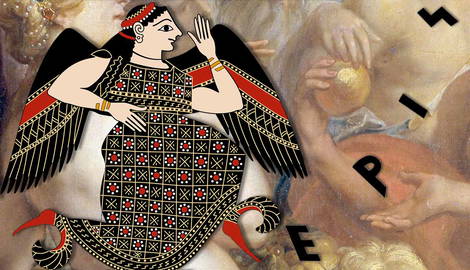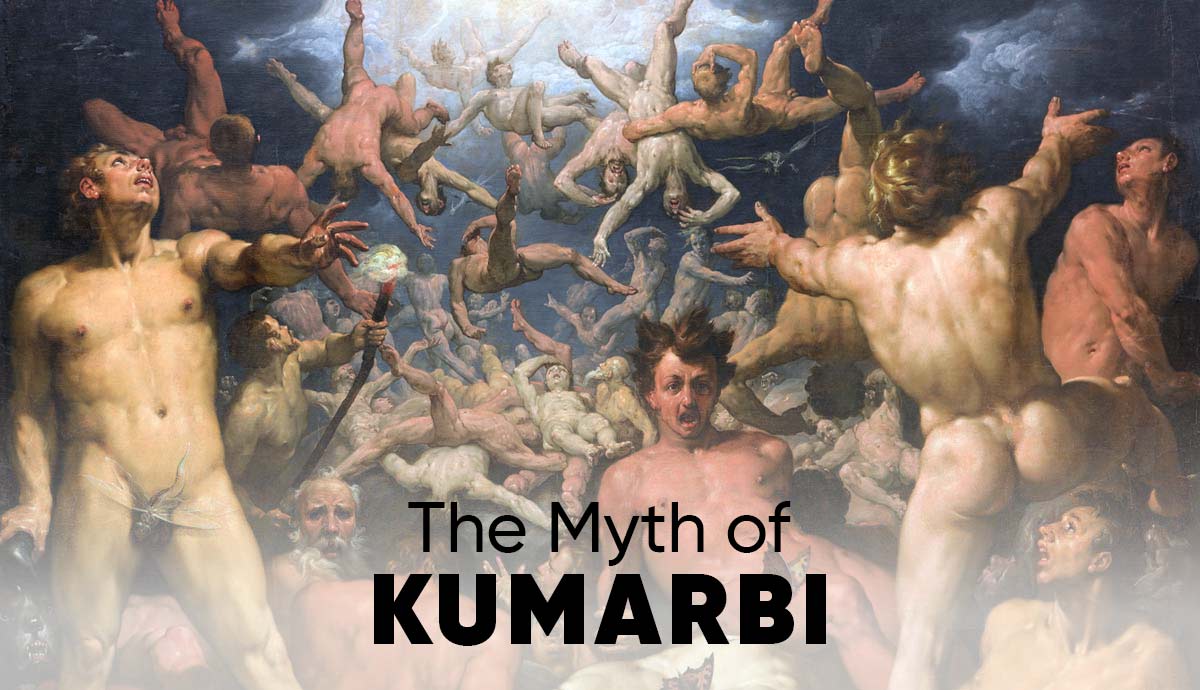
Eris was the personification of strife and discord in Greek mythology, said to delight in the slaughter of men and any kind of conflict. Her Roman counterpart was named Discordia, and in art, she was represented as a winged woman with dark, braided hair and hideous features. Her image was rendered on armor to intimidate anyone who looked upon it, such as on Zeus’ aegis or the shield of Heracles. Eris appears in relatively few myths and acts more as an achieved condition than an active character. When she does feature in stories, once discord has been created, Eris drops out of the story as a character and becomes the thematic representation of conflict.
Eris: Child of Night

According to Hesiod’s Theogony, Eris was born after Ouranos’s castration to the primordial goddess of night, Nyx. She was one of several siblings, the vast majority of whom were plagues to mankind, such as Blame, Woe, Deceit, and Old Age. She was imagined as a purely negative figure, one that must be avoided at all costs.
In Works and Days, another work by Hesiod, he revisits his idea of Eris as a purely negative deity. He instead claims that there were, in fact, two goddesses named Eris. One was negative, reveling in the strife of war and violence, but the other was the eldest daughter of Nyx and Zeus and represented healthy, competitive strife. This Eris was viewed as a positive figure, one who fostered productive jealousy.
Much of Greek myth cautions against the dangers of excess, so the idea that some strife is wholesome and engenders self-improvement, while too much strife is a detriment and leads to self-destruction, would not have been a novel concept. As Hesiod put it: “[…] a man grows eager to work when he considers his neighbor, a rich man who hastens to plough and plant and put his house in good order; and neighbor vies with his neighbor as he hurries after wealth.” For a poor man, the good Eris inspires him to work and to lift himself up from poverty, while the bad Eris embroils men in disputes, seeking to take from others to gain more for himself.
Goddess of War

Homer recorded a different lineage for Eris than Hesiod. In the Iliad, Eris is described as the sister and companion of Ares, which would make her a daughter of Zeus and Hera. Given her function as a war goddess, she was also sometimes equated with the goddess Enyo. Their names are used almost interchangeably in both the Iliad by Homer and the Posthomerica by Quintus Smyrnaeus.
Hesiod’s Theogony, however, presents Enyo as a distinct goddess. She was the daughter of Phorcys and Ceto and one of three sisters called the Graiae or Grey Sisters. Old women from birth, the three shared an eye and a tooth. In the story of Perseus and his quest to slay Medusa, he visits the Graiae to discover the Gorgon’s location. It was only after stealing their eye that they revealed the location to him.
Mother of Evils

Eris had many children, all of which were a plague to humanity. Through parthenogenesis, meaning virgin births, she gave birth to Ponos, the personification of toil or work; Lethe, the personification of forgetfulness; Limos, the spirit of famine; Algea, the spirit of pain; the Hysminae, Makhae, Phonoi, Androctasiae, and Neicea, all spirits of violence, murder, and quarreling. She also gave birth to the personifications of lies, arguments, lawlessness, and ruin. Another of Eris’ children was Horcus, who personified oaths.
Hesiod also created a link between Eris and the story of Pandora. When the accounts of Eris in the Theogony and Works and Days are taken together, it is clear that Hesiod envisioned that Pandora was the cause of Eris’ influence on mankind. Before the creation of Pandora, Hesiod wrote that men lived without work, sickness, or bad things of any kind. It was only once Pandora lifted the lid from the jar (in Hesiod, the proverbial “Pandora’s box” was envisioned as a jar) that all of these troubles for men were scattered into the world. Troubles which were personified as the children of Eris.
Marital Strife: Polytechnus and Aedon

In a variation on the story of Procne and Philomela, Antoninus Liberalis, in his Metamorphoses, wrote of a happy couple who once lived in Lydia, a carpenter named Polytechnus, and his wife Aedon. They had a son named Itys, and for a long time, they lived in bliss. However, one day, they thoughtlessly declared that they loved each other more than Hera and Zeus. In typical fashion, Hera took offense at the remark and sent Eris down to create marital strife between the couple and pit the two against each other.
One day, while Polytechnus was building a standing board for a chariot and Aedon was weaving, they made a bet that whoever should finish first would give the other a female servant. With the help of Hera, Aedon finished her weaving first. This infuriated Polytechnus, so he went to Aedon’s father, Pandareos, saying that she had sent him there to fetch her sister, Chelidon. Having no reason to be suspicious of his son-in-law, Pandareos sent Chelidon back with him. But when they were alone on the road, Polytechnus raped her. He then cut her hair short and gave her different clothes, threatening to kill her if she told Aedon what had happened. Returning home, Polytechnus gave Chelidon over to Aedon as the promised servant, but Aedon didn’t recognize her sister.

One day, Chelidon was at a spring lamenting her situation when Aedon overheard her and finally recognized her sister. Together, they plotted vengeance against Polytechnus. They chopped up Itys and cooked him in a cauldron. Aedon then had a neighbor call upon Polytechnus and trick him into eating the stew while the two women fled back to their father, Pandareos.
When Polytechnus realized that he had just eaten the flesh of his son, he chased after them. When he arrived at the house of Pandareos, he was captured and bound by servants, then smeared with honey and thrown into a sheep pen. Biting flies descended on him, but Aedon took pity on him, remembering the love they once shared. She tried to keep the flies off him, but when her family saw what she was doing, they tried to kill her. To prevent more tragedy, Zeus turned them all into birds.
The Apple of Discord and the Judgement of Paris

When the goddess Thetis was married to the mortal hero Peleus, all the gods and goddesses were invited to celebrate the wedding. All except for Eris. When she tried to attend, she was turned away. Angry at her mistreatment, Eris threw a golden apple into the party and said it was for the most beautiful. Three goddesses tried to claim it: Hera, Athena, and Aphrodite. They argued over who should get the apple. Eventually, it was decided that Paris, a Trojan prince, would judge the winner.
Hermes brought the goddesses to Mount Ida in Asia Minor, not to be confused with Mount Ida in Crete, where each goddess offered Paris a prize should he pick them. Hera offered him dominion over all kingdoms of the earth; Athena offered him mastery of the battlefield; and Aphrodite offered him the most beautiful woman in the world, Helen of Sparta. Paris picked Aphrodite, causing Hera to become filled with a burning hatred for the Trojans. She would not let go of this hatred until the city of Troy was razed to the ground. The judgment of Paris and his subsequent carrying off of Helen were what incited the Trojan War.
Eris and the Trojan War

Eris shows up several times during the events of the Iliad, but her presence can be felt from the outset of the poem. She is not only an active character but also represents a deterioration of the order of the cosmos that gradually amplifies as the narrative progresses.
Beginning in Book 3, Menelaos and Paris agreed to duel in single combat to determine the war’s outcome and who should win Helen. They both swore a sacred oath and called upon the gods as witnesses to guarantee the terms. They fought, and Menelaos was victorious, but through the intervention of Aphrodite, Paris was whisked away to safety.
On Olympus, Zeus and Hera discussed what to do about the duel. Should they continue the war, or should they enforce peace between the Greeks and Trojans? It is at this moment that Hera introduced Eris into the war. She was so enraged at the Trojans that she convinced Zeus to send Athena to the Trojans and have them break the terms of the oath. Athena convinced Pandaros to fire an arrow at Menelaos, wounding him and inciting the war to start again. In the ensuing battle, Eris appears on the battlefield for the first time.
Eris next appears at the beginning of Book 11, when Zeus sends her down to the Greek camps to stir them to war. She positioned herself in the center of the camps by Odysseus’ ship and let out a terrible shout that filled the hearts of the Greeks with a desire to fight. Agamemnon then called the Greeks to array for war. As the Greeks and Trojans clash, Eris is shown to be the only of the gods present on the battlefield. Homer makes a contrast between her and the other gods, writing, “for alone of the gods she was with them in their fighting; whereas the other gods were not among them, but abode in peace in their own halls[…]” Here, she is still only affecting the mortals fighting in the war, but soon her influence will even envelop the gods.

In Book 20, Zeus gives permission to the gods to engage in the war and to choose whichever side they favor. Hera, Athena, Poseidon, Hermes, and Hephaestus sided with the Greeks, while Ares, Apollo, Artemis, Leto, Xanthus, and Aphrodite sided with the Trojans. As they descended, Eris joined in the battle, rousing both sides to fight against each other. In this way, we see how Eris even affects the gods as they all fight against each other. In a sense, Eris is the most active of the gods in the Iliad, given that she is present in every battle, whether between gods or men, and chooses no side. She simply delighted in the death and bloodshed.










